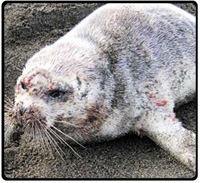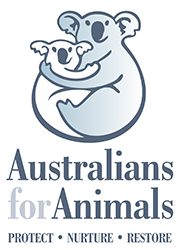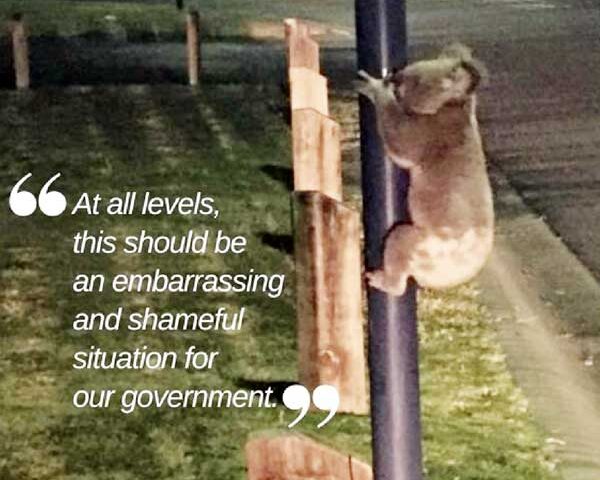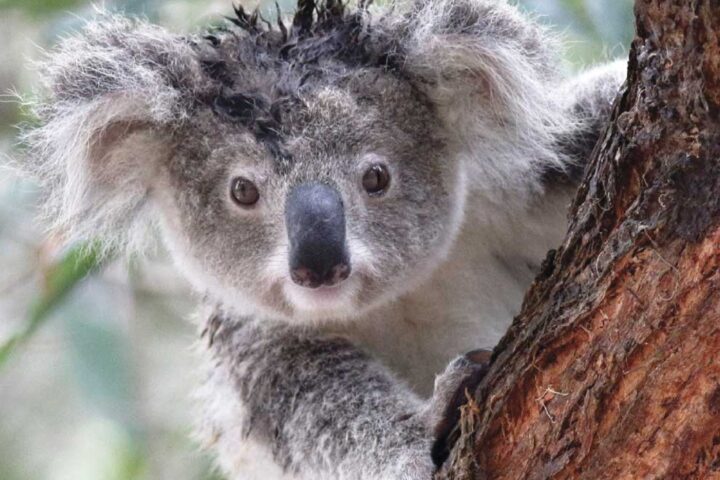GLADSTONE – GREAT BARRIER REEF DISASTER
As the reports of sick and diseased fish, sharks, rays, dolphins, dugongs and other critters became increasingly urgent, Australians for Animals Committee took the decision to bite the bullet and take on Gladstone and the impacts of the coal seam gas industry on the Great Barrier Reef as a major campaign.
 The first priority in the New Year was to send our Co-ordinator Sue Arnold to Gladstone and Rockhampton to see first hand what is actually happening in Central Queensland. Sue will tell the story in her own words.
The first priority in the New Year was to send our Co-ordinator Sue Arnold to Gladstone and Rockhampton to see first hand what is actually happening in Central Queensland. Sue will tell the story in her own words.
“ My first port of call was to Rockhampton as I wanted to meet with the folks who run the Capricorn Conservation Council. Chantelle and Michael have been doing an incredible job working on the Gladstone/ Great Barrier Reef issues as well as struggling to cope with the incredible number of coal mines, coal seam gas and proposed industrialization of Central Queensland.
“It’s mind-boggling to witness the sheer extent of development which has been given the go-ahead by the Anna Bligh government . And even more depressing to realise that none of the major environmental organisations in this country have mounted major campaigns against this awesome level of destruction.
In Gladstone, the Gladstone Conservation Council has the support of some dedicated people but they’re holding down jobs and attempting to run a campaign against an extremely well funded, hostile resource industry.
It’s almost impossible to get an objective story out of the local paper. The Gladstone Mayor is very defensive about the mining industries rape of the town, insisting that Gladstone has benefited from the usual hand-outs which resource industries and developers make available in an effort to “ smoothe things over”.
“ The marine environment around Gladstone is a national environmental disaster. The number and species of marine creatures affected by the dredging and development constitutes an environmental disaster of major proportions.
“In Gladstone, I met with the Mayor, the CEO of the Gladstone Port Corporation which has responsibility for the four LNG ( Liquified Natural Gas) terminals currently being constructed, as well as the CEO of the Gladstone Fish Market, Ted Whittingham and many other community leaders.
Walking along Goondoon Street, if I ran my fingers along the ledges the coal dust was really evident.
Gladstone should be on the compulsory viewing list for the Prime Minister, the Minister for the Environment and every Minister in the Gillard government involved in giving consent to the destruction of Gladstone and surrounds.
BYRON SHIRE ECHO ARTICLE
ON GLADSTONE
Sue Arnold
Gladstone is probably a writeoff.
A sacrifice on the altar of Australia’s destiny as a gigantic quarry. It’s heart breaking to witness the devastation wreaked on the magnificent harbour, wetlands and surrounding islands.
In 26 years of environmental activism, I haven’t seen such a monumental environmental and social tragedy. The Gladstone saga qualifies as an international environmental emergency because it threatens the World Heritage status of the Great Barrier Reef marine park and demonstrates a terrifying template of future mining developments along the east andwest coasts of Australia as well as the top end.
Acid barges
The once beautiful harbour is now a sea of industrial machinery, cranes, smokestacks, wharves and a scarred, scraped-clean waterfront. Dredges go back and forth digging up the seagrass beds, turning the waters of the harbour into pea soup. Huge barges full of acid sulfate soil dotted around the foreshore, dredging, recreational and fishing vessels on the water.
Commercial fishermen are still catching sick fish covered in lesions. On the day I visited Ted Whittingham, head of the beleaguered Gladstone Fish Market, some fishers had brought in a shark, its flesh now bright pink, bleeding from its back passage. I was shown a live crab with half its shell eaten away as though by acid. To the layperson, all the shell erosion and extensive pink flesh found on many marine creatures looks like burned flesh. Ted explained, ‘They’re dredging up acid sulfate soil and loading it into barges. If the soil isn’t disposed of within 24 hours, it becomes sulphuric acid. We’ve seen barges left for days before dumping their loads into the harbour.’
Although a recent desktop study undertaken at the request of the Queensland minister for fisheries gave dredging the all-clear in terms of damage to fish, the terms of reference did not include any impact from dredging. Nor was any cause found for the reddened skin seen on many fish, sharks, stingrays, turtles and other species.
Savage blow
Commercial fishing in Gladstone has been dealt a savage blow. Gladstone Fish Market once provided 50 per cent of all mud crabs in Queensland; the catch is now down by between 50 and 70 per cent. A lucrative export and domestic scallop fishery is on its knees with the catch reduced from around 1300 tonnes down to 300. Fishers are suffering from appalling stress as they watch their industry in its death throes.
Ted Whittingham describes the harbour as a ‘dead sea’. He says there’s zero recruitment. To date, 2,856,000 cubic metres of dredging has occurred. Just a smidgin of the 46 million cubic metres to be removed over the next 20 years. ‘Put it in perspective,’ says Ted, ‘most people can’t imagine what 46 million cubic metres looks like.
If you stretched it out in a line, it would go half way round Australia!’
I met with Leo Zussino, CEO of the Gladstone Port Corporation, who has responsibility for the dredging to service four LNG terminals. Born and bred in Gladstone, Leo Zussino is a powerful man who casually drops the names of federal and state government ministers like confetti. A lifetime member of the ALP, Leo is very well connected.
He also chairs the Australia Maritime Safety Authority, which some say is a conflict of interest.
Not content with the massive workload, Mr Zussino also chairs the Gladstone Economic and Industry Development Board which has as its focus a vision of Gladstone as ‘the model 21st Century City,’ according to the board’s literature.
The Gladstone Ports Corporation is registered as a Company Government Owned Corporation (CGOC) under Queensland’s Government Owned Corporations Act, with three shareholders who are all Queensland government ministers.
Neither the federal or Queensland governments’ conditions of consent are designed to adequately protect or monitor any threatened or endangered marine species.
Leo acknowledges but dismisses the fact that dredging is damaging Gladstone Harbour, insisting that seagrass beds are coming back and that the diseased fish is a result of the 2011 flooding over the Awonga Dam which washed some 30,000 Barramundi into the Harbour system.
The Gladstone Ports Corporation is registered as a Company Government Owned Corporation (CGOC) under Queensland’s Government Owned Corporations Act, with three shareholders who are all Queensland government ministers. Neither the federal or Queensland governments’ conditions of consent are designed to adequately protect or monitor any threatened or endangered marine species.
Dredging impact
This assertion ignores the evidence from overseas and within Australia that dredging damages the marine environment. Many scientists liken dredging to strip mining. Ironically, on the day of day of my meeting with Leo Zussino, the Department of the Environment and Resource Management (DERM) halted dredging because of turbidity. However, only the big dredge stopped, smaller ones continuing their destructive path.
Along with other Gladstone supporters of the massive industrial development, Leo believes the Gladstone Fish Health Scientific Advisory Panel Report released on January 5 gives dredging a clean bill of health. In fact, dredging is only mentioned once in the 47- page report and is ignored as a stressor. But one sentence in
the report says it all.
‘The Panel noted the current parameters measured may not provide an appropriate trigger for ecosystem health problems that may be responsible for the observed fish health issues in Gladstone Harbour.’
The crux of the debate is the failure to take into account the extent of damage to endangered dolphins, turtles, dugongs, pelagic and coastal fish, prawns, scallops, sharks, rays and other marine species. American scientists say the sheer numbers of species affected are an indication of a major ecosystem crisis. Water tests fail to take into account the full range of contaminants
allowing state and federal governments to ignore a marine catastrophe.
In spite of growing evidence in Gladstone, the federal government plans to double the amount of dredging inside the Great Barrier Reef’s world
heritage area.
Increased levels
Senate estimates figures, released last week by Greens senator Larissa Waters, show plans to increase seabed dredging by 17 times the October 2010 levels in order to allow super tankers to remove oil and natural gas from Queensland ports.
Undeterred by these events, Gladstone Area Promotion and Development Ltd, publisher of fancy brochures found at hotels, airports and tourism places, writes, ‘Gladstone: unique, unforgettable and truly special. With such contrasting features of industry, nature and the world heritage listed Great Barrier Reef, Gladstone creates an unlikely, exciting and interesting destination.’ And further down, ‘the shimmering water of Gladstone Harbour continues to attract people to the city from around the globe and encourages further exploration.’
A UNESCO World Heritage team will visit Australia to inspect Gladstone and the Reef from March 6 to 12.
JAPAN’S TERRIBLE TSUNAMI TOLL
With tsunami debris calculated to be twice the size of Texas heading for the West Coast of the US, the issue of Japan’s Tsunami and ongoing irradiation of the planet has been kept under wraps by the Australian and US media.
 The photo to the right shows one of more than 60 dead and 75 diseased seals that have been found since mid-July, with skin lesions and hair loss in the Arctic and Bering Strait regions of Alaska. All standard tests have failed to reveal the cause of the problem but some scientists believe it is radiation fall-out.
The photo to the right shows one of more than 60 dead and 75 diseased seals that have been found since mid-July, with skin lesions and hair loss in the Arctic and Bering Strait regions of Alaska. All standard tests have failed to reveal the cause of the problem but some scientists believe it is radiation fall-out.
In spite of news that Japan has the reactors under control, nothing could be further from the truth.
The Pacific ocean has been contaminated and continues to be contaminated as thousands of tons of irradiated water are dumped into the sea.
When the huge mass of houses, boats, debris and potentially human bodies wash up on the shores of the west coast of the US, Canada and Alaska, ( and the debris has already started to wash up in many areas), it will be impossible for politicians and the media to continue this appalling shut down of information.
AFA has been told there was a major radiation spike on the Sunshine Coast some weeks ago but we have no way of knowing if it was caused by Fukushima.
NSW GOVERNMENT MUST DEAL
WITH THE LACK OF ANIMAL
WELFARE INSPECTORS.
Not long before Christmas, the local Northern Star newspaper ran a front page story on a 3 month old puppy which had been severely bashed and dumped in a garbage bin and left for dead.
 Thanks to some caring garbos at the Woodenbong Tip, the pup was found. Barely alive with terrible head injuries. She was taken to a vet clinic where incredibly, the pup began the long journey of recovery. Australians for Animals was appalled by what happened. We called the newspaper and offered a $1000 reward to any information leading to the arrest and conviction of the perpetrators. The office was deluged with phone calls from people who were willing to give the puppy a home, to sit by the distressed animal at the vet clinic, as we had heard on the grapevine that the pup cried and cried for days. People offered to help with funding to pay vet costs. It was an amazing outpouring of concern.
Thanks to some caring garbos at the Woodenbong Tip, the pup was found. Barely alive with terrible head injuries. She was taken to a vet clinic where incredibly, the pup began the long journey of recovery. Australians for Animals was appalled by what happened. We called the newspaper and offered a $1000 reward to any information leading to the arrest and conviction of the perpetrators. The office was deluged with phone calls from people who were willing to give the puppy a home, to sit by the distressed animal at the vet clinic, as we had heard on the grapevine that the pup cried and cried for days. People offered to help with funding to pay vet costs. It was an amazing outpouring of concern.
As well, the Northern Star was fantastic, running daily articles on the pup and giving AFA’s reward offer major publicity.
And in due course, we did get a phone call from an informer which had a great deal of credibility.
But, as always, the Prevention of Cruelty to Animals Act ( POCTA) is so poorly written that unless there was a witness to the actual bashing and dumping of the pup, there could be no charges laid against the person(s) who committed this awful act.
The RSPCA took control of the pup’s welfare, shutting down all information on the pup’s condition and ordering the vet clinic not give out any information.
In the past, AFA has had many many complaints about the RSPCA NSW. And we’ve had a few ourselves as we’ve been aware of animals that have suffered and died because no inspector was available to investigate cruelty complaints.
It is absolutely outrageous and unacceptable that an area the size of Tasmania with more than 200,000 people has one RSPCA Inspector to cover complaints from Coffs Harbour to the Queensland border. When he goes away or is not available, there’s no one.
Although the police have the same powers to enforce the POCTA, it is a rare situation when they are actually willing to act. Most phone calls result in the same old response.
“ Call the RSPCA.”
If you do call the RSPCA, you will get caught up in a phone system which is not conducive to any complaint about cruelty.
The RSPCA NSW refuses to appoint another inspector for the Far North Coast leaving animal welfare groups and shelters having to deal with a massive increase in cruelty with no powers to seize, arrest or charge offenders.
But back to the pup. Because it’s a good example of what’s going on. Once the RSPCA asserted “ ownership” of the pup, the vet clinic was instructed to give no information to anyone on the condition of the pup. Phone calls to the RSPCA enquiring about the pup’s condition were unanswered or ignored.
AFA called the local inspector to say we had a long list of people willing to give the pup a home and to help with costs. But these good people were also ignored. Now weeks later, the RSPCA refuses to tell anyone, including the newspaper, where the pup is, nor will they allow any photos to be taken.
Given the appalling story of a woman who threw her pup out of a window in a first story apartment in Sydney which was featured on the front page of the Daily Telegraph, it’s hard to understand the RSPCA’s attitude.
The Daily Telegraph followed the pup’s progress publishing photos of the little fella with one leg in plaster. The paper continued to follow his progress as a new home and owner were found and the woman was charged and brought to court.
So why the secrecy on the Far North Coast ? No one has been charged, there’s absolutely no reason why the caring public cannot be told of the pup’s progress or a photo taken.
In spite of a request by AFA to use a photo of the pup for the reward notices that we put up around the area, RSPCA refused.
These are not the actions of an organisation that has any desire to work with other animal welfare organisations. It’s time the “ ownership” of inspectors in NSW was broadened to include Council Rangers and animal welfare shelters who need to be funded so that inspectors can be employed.
The NSW government’s Minister in charge of the RSPCA is Katrina Hodgkinson. Ms Hodgkinson refuses to answer letters and will not respond to concerns about the exponential increase in cruelty on the Far North Coast much less other regions desperate for more Inspectors. Her attitude is one of complete contempt.
When animal cruelty and abuse is on the rise, so too is abuse of children and domestic violence.
AFA is sick to death of hearing stories about dogs tied up 24 hours a day on chains without exercise, water and adequate food. We’re tired of seeing photos of starving horses and horses who are cruelly and brutally treated.
But most of all, the charity is DISGUSTED with the failure of the NSW government to address the problem and we will be pushing this campaign as hard as we can this year.
The charity has had discussions with Church leaders and gained the support of the Catholic Bishop in Lismore as well as support from the Lismore Mayor, the Northern Star, and Federal MPs. Regretfully, the state member for Lismore, Thomas George has the same disease as Minister Hodgkinson, ignoring letters and emails of concern. These two politicians are members of the National Party which should hang its head in shame over its failure to address the appalling rise in animal cruelty.
AFA is flat chat with the Great Barrier Reef issues but the charity has always had major concerns over animal cruelty. We believe this is an issue no responsible human being can ignore.
Animals cannot speak, they are entirely reliant on human beings to protect them, care for them and to behave in compassionate and responsible ways. The volume of complaints is an indication of major social problems which will not go away.
If the politicians who ignore this issue were forced to spend a week in an animal shelter, they would have to deal with the consequences of their ignorance and refusal to take action.
NSW MUST HAVE MORE INSPECTORS AND THE FAR NORTH COAST DESPERATELY NEEDS AT LEAST ANOTHER TWO FULL TIME INSPECTORS.
Please take the time to contact your local State MP or Member of the Upper House and let them know that the Government must take steps urgently to fund inspectors and give Council Rangers powers to act under the anti cruelty legislation.
A LOVELY SEAL STORY (From NZ Herald)
A woman in New Zealand couldn’t believe her eyes when a seal pup wandering around her town made himself at home in her living room on Sunday night.
 The baby fur seal had been hopping around town all day when he eventually came in through the cat flap of Annette Swoffer’s home for a well-earned kip.
The baby fur seal had been hopping around town all day when he eventually came in through the cat flap of Annette Swoffer’s home for a well-earned kip.
Making himself at home, he bedded down on her sofa in the Bay of Plenty having tired himself out.
The seal had lolloped all the way up from the waterfront, through a residential area, up a slip road, up a driveway, under a gate and in through the cat flap of Swoffer’s house.
She was in her office when she heard some commotion downstairs. She saw the pup’s huge brown eyes staring back at her as it hopped around among her cats and her dog in the kitchen.
The excitable young pup moved past her to find a cosy spot on the sofa.
Swoffer rang the local Department of Conservation to come and collect him. It turned out that they were already looking for him, as an officer had spent the day trailing around town trying to capture him.
The Department of Conservation was called out again on Tuesday, as it seems that the same pup was spotted making his way up another residential street. He probably had a certain sofa in mind.
WHO SAYS ANIMALS ARE
NOT INTELLIGENT ?
AFA loved this story which appeared in a British newspaper not long ago. Apparently switching to digital television is likely to have transformed your dog’s relationship to TV.
So much so that the average British pooch now watches 50 minutes of television a day, with one in 10 watching at least two hours according to recent research.
The faster digital images apparently allow them to see TV the same way we do.
As a result of the changes, dog owners across the UK are reporting that many pets have become television addicts. Soaps were very popular but noisy game shows were shunned.
AFA NEEDS
YOUR SUPPORT
 In 2012, AFA will be working on major issues doing what we do best. Helping other grass roots and community organisations with good research, legal help, funding when possible.
In 2012, AFA will be working on major issues doing what we do best. Helping other grass roots and community organisations with good research, legal help, funding when possible.
The charity continues to compile in depth scientific submissions for community organisations to use. Our Co-ordinator will be submitting articles to the international media in an effort to raise the profile of the Great Barrier Reef marine issues.
A lot of travel will be on the agenda as well since there is no substitute for face to face meetings and witnessing the disaster zones first hand.
Your help makes all our work possible.
For the Animals,
Sue Arnold & Friends





